2 Ways to Upgrade From Ubuntu 22.04 To 22.10 (GUI & Terminal)
Ubuntu 22.10, codenamed Kinetic Kudu, will be released on October 20, 2022. This tutorial will be showing you 2 ways to upgrade Ubuntu 22.04 to Ubuntu 22.10. The first method uses the graphical update manager and the second method uses the command line. Usually, you use the graphical update manager to upgrade Ubuntu desktop and use the command line to upgrade Ubuntu server, but the command-line method also works for desktops.
Note that Ubuntu 22.04 is a long-term support (LTS) release, which will be supported for 5 years. Ubuntu 22.10 is a non-LTS release, which means it will be supported for 9 months only, until July 2023. If you prefer stability over bleeding edge, then stick with Ubuntu 22.04. But if you are the other way around, you can follow this tutorial to upgrade from Ubuntu 22.04 to Ubuntu 22.10.
Ubuntu 22.10 New Features
- Linux kernel 5.19. You will also get all the new features from kernel 5.16, 5.17, and 5.18, such as VirtualBox folder sharing, Thunderbolt 3 and USB4 support, Apple USB fast charge, EFI mixed mode booting, full support for exFAT, which is a file system optimized for flash memory that allows file size larger than 4GB.
- GNOME 43
- PipeWire replaces PulseAudio as the default sound system.
- The file manager supports WebP image format out of the box.
- Nginx 1.22, PHP8.1, Ruby 3.0, Python 3.10, OpenJDK 8, 11, 17, 18, 19 and 20.
Note: Before doing the upgrade, you can use the systemback program to create a bootable ISO image from your current OS. If the upgrade fails, you can easily restore your OS with the bootable ISO. Everything on your OS including software and files will be intact. If you are using a laptop, please connect your power source.
Upgrade Ubuntu 22.04 to Ubuntu 22.10 with the Graphical Update Manager
First of all, open software updater (aka update manager) from your application menu. It will update software package information. If there’s updates available, click the Install Now button and enter your password to install updates.
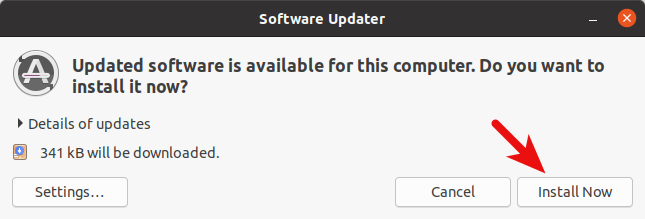
If a new version of the Linux kernel is installed, then the update manager will tell you to restart your computer. Click Restart Now.

Then open Software & Updates from your application menu.

Select the Updates tab and then at the bottom of the window, change notification settings from For long-term support version to For any new version. You will be asked to enter your password for the change to take effect. Then close this window.
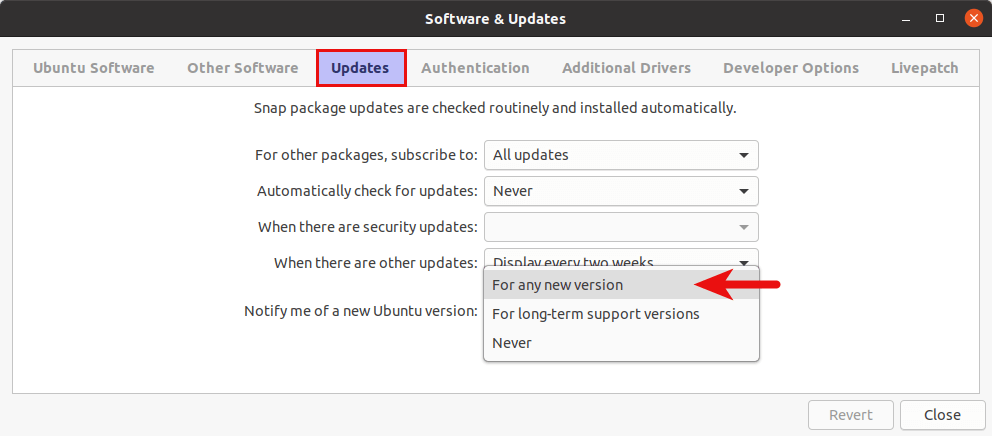
Next, open up a terminal window and issue the following command in the terminal.
update-manager -d
After checking for updates, the update manager will tell you that Ubuntu 22.10 is now available. Click the Upgrade button.

Then enter your password. The release notes window appears. Click Upgrade.
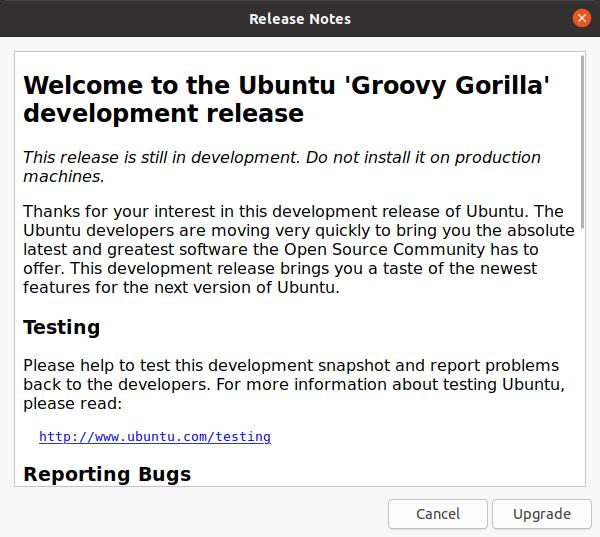
The distribution upgrade window will open up. If you are notified that some third-party sources are disabled, accept it. You can re-enable them after the upgrade is finished. (The window says “upgrading Ubuntu to version 22.04”. Actually it’s upgrading Ubuntu to version 22.10.)

In a few moments, you will be asked if you want to start the upgrade. Click the Start Upgrade button.
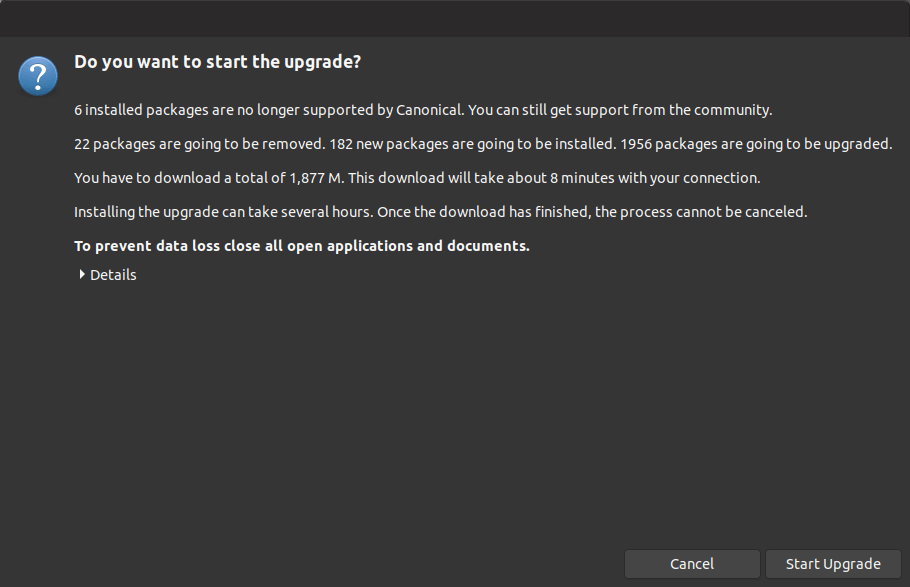
Wait for the upgrade process to finish. The update manager may ask you if you want to restart services during packages upgrade without asking. Tick it on and click Next button.

After new versions of packages are installed, the update manager may ask you if you want to remove obsolete packages. I always select Remove.

Obsolete packages are software packages whose name can’t be found in the software repository of the new Ubuntu release. The cause of obsolete packages are the following:
- The upstream developer stops maintaining this package and there is no other person willing to take over. So the Ubuntu package maintainer decides to drop this package from the Ubuntu repository.
- The package becomes an orphan package, which means there’s no other package that depends on it and there are very few users of this package. So the Ubuntu package maintainer decides to drop this package from the Ubuntu repository.
- The package has a new name in the software repository of the new Ubuntu release.
After obsolete packages are removed from your system. Restart your computer and check your Ubuntu version with the following command.
lsb_release -a
Output:
No LSB modules are available. Distributor ID: Ubuntu Description: Ubuntu 22.10 Release: 22.10 Codename: kinetic
Upgrade From Ubuntu 22.04 to Ubuntu 22.10 Using Command Line
You can use the command line to upgrade Ubuntu desktop or a headless server. If you use SSH to log into your Ubuntu server, it’s a good idea to keep your OpenSSH session alive by adding the following line in the /etc/ssh/sshd_config file on your server.
ClientAliveInterval 60
Save and close the file. Then restart the SSH daemon.
sudo systemctl restart ssh
To upgrade to Ubuntu 22.10, first run the following command to update existing software packages.
sudo apt update && sudo apt dist-upgrade
Please note that if a new kernel is installed while running the above command, you need to reboot the system (sudo shutdown -r now) in order to continue the upgrade process.

Then make sure you have update-manager-core package installed.
sudo apt install update-manager-core
Next, edit /etc/update-manager/release-upgrades file with a command-line text editor like Nano.
sudo nano /etc/update-manager/release-upgrades
Change the value of prompt from lts to normal.
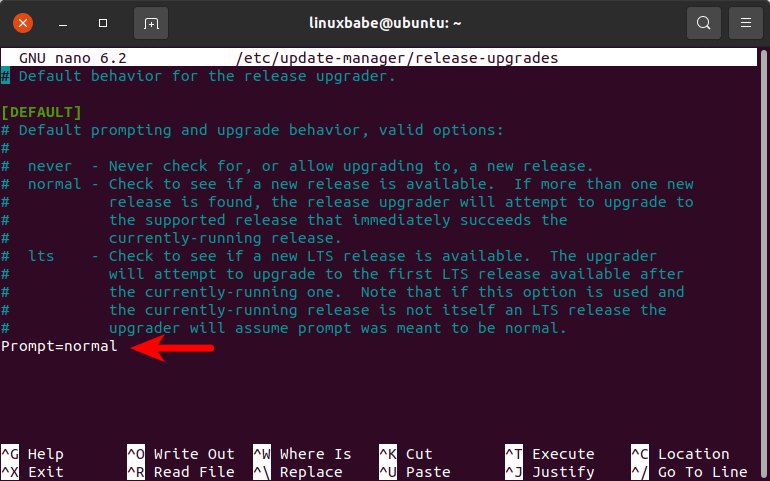
To save a file in Nano text editor, press Ctrl+O, then press Enter to confirm. To exit, press Ctrl+X. After that, run the following command to begin the upgrade process.
do-release-upgrade -d
Then follow the on-screen instruction to upgrade to Ubuntu 22.10. Basically, you need to press y to answer the questions.
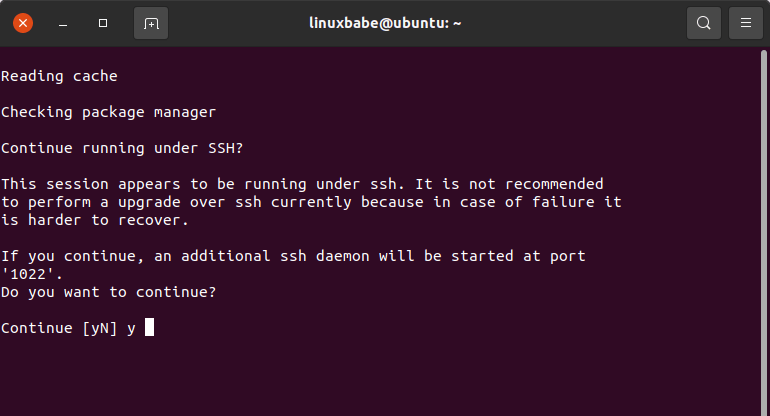
The update manager may ask you if you want to restart services during packages upgrade without asking. Press the Tab key to select Yes and press Enter.
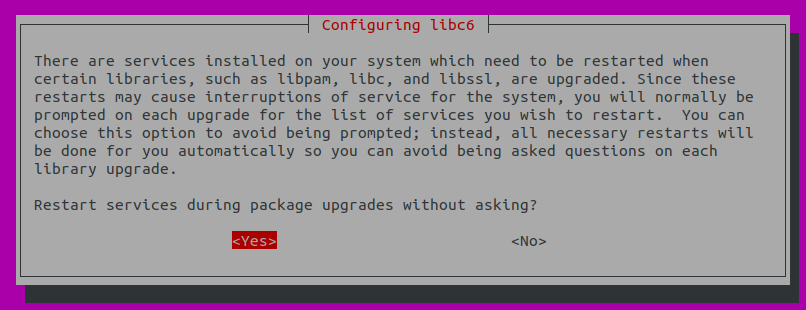
If you are upgrading a server, you will probably see messages like below. I recommend choosing N to keep your current version. The updated version will be available at the same directory. You can check it out later.

Once the upgrade is finished, reboot your Ubuntu desktop or server. To check your Ubuntu version, run:
lsb_release -a
Output:
No LSB modules are available. Distributor ID: Ubuntu Description: Ubuntu 22.10 Release: 22.10 Codename: kinetic
Troubleshooting
If you see the following error message when upgrading from the command-line.
After updating your package information, the essential package 'ubuntu-minimal' could not be located. This may be because you have no official mirrors listed in your software sources, or because of excessive load on the mirror you are using. See /etc/apt/sources.list for the current list of configured software sources. In the case of an overloaded mirror, you may want to try the upgrade again later.
Then you need to switch to a different software repository mirror. For example, I’m using the mirrors.ustc.edu.cn mirror, I can switch to the us.archive.ubuntu.com mirror with the following command.
sudo sed -i 's/mirrors.ustc.edu.cn/us.archive.ubuntu.com/g' /etc/apt/sources.list
Then update the package repository.
sudo apt update
Upgrade to Ubuntu 22.10 again.
do-release-upgrade
Please install all available updates for your release before upgrading
If you see the following message when trying to upgrade, then you need to update all packages (sudo apt update;sudo apt upgrade -y) then restart the OS and try to upgrade again.
Please install all available updates for your release before upgrading.
Sometimes your system may have some package kept on hold, which can be shown with:
sudo apt-mark showhold
You need to unhold the package.
sudo apt-mark unhold package-name
Then run
sudo apt upgrade
Sometimes, sudo apt update tells you that a package can be upgraded, but sudo apt upgrade won’t upgrade the package, then you can run the following command to list the package.
apt list --upgradable
Now you can upgrade the package.
sudo apt upgrade pacakge-name
If this is a broken package that can not be upgraded, then remove it.
sudo apt remove package-name
How to Re-Enable Third-Party Repositories
Third-party repositories are defined in the .list files under /etc/apt/sources.list.d/ directory. First, re-enable third-party repositories with the following command, which will remove the # character in lines that begin with deb.
sudo sed -i '/deb/s/^#//g' /etc/apt/sources.list.d/*.list
Then change all instances of focal to groovy.
sudo sed -i 's/focal/groovy/g' /etc/apt/sources.list.d/*.list
Update package repository index.
sudo apt update
Some third-party repositories don’t have an entry for Ubuntu 22.10, so you will likely to see errors like:
E: The repository 'http://linux.dropbox.com/ubuntu focal Release' does not have a Release file. N: Updating from such a repository can't be done securely, and is therefore disabled by default. N: See apt-secure(8) manpage for repository creation and user configuration details.
You will need to edit these repository files one by one and disable them. For example, I edit the Dropbox repository file.
sudo nano /etc/apt/sources.list.d/dropbox.list
Disable this repository by adding the # character at the beginning of the line.
# deb [arch=i386,amd64] http://linux.dropbox.com/ubuntu focal main # disabled on upgrade to focal
Save and close the file. You need to wait for those repositories to add support for Ubuntu 22.10. Some software packages in third-party repositories might be included in 22.10. For example, Ubuntu 22.10 repository contains the nextcloud-desktop package, so I don’t need the Nextcloud PPA anymore. I can delete the Nextcloud PPA.
sudo rm /etc/apt/sources.list.d/nextcloud-client.list*
Wrapping Up
That’s it! I hope this tutorial helped you upgrade to Ubuntu 22.10 from Ubuntu 22.04. You may also want to read:
As always, if you found this post useful, then subscribe to our free newsletter to get new tutorials. Take care 🙂



I got a segmentation fault when running the command “do-release-upgrade” – it occured right after it began “reading cache”.
I found a posting on askubuntu.com that listed the command as “do-release-upgrade -d” and that seems to be working.
Thanks linuxbabe!
so theres just this issue that it just says “~$ do-release-upgrade -d
Checking for a new Ubuntu release
Upgrades to the development release are only
available from the latest supported release.
and i have no idea how to fix this